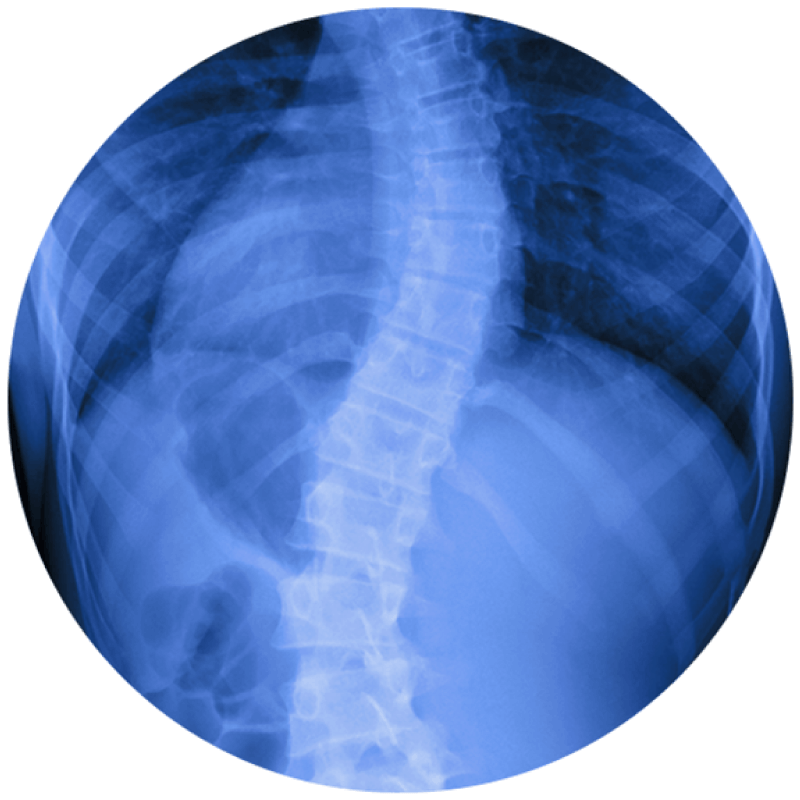Pediatric Scoliosis

Pediatric Scoliosis Symptoms & Treatment Options
The human spine is genetically designed to take on a certain shape that will best support the body. Viewed from the front, the spine will appear straight up and down; from the side, it will form a gradual S-curve. When this typical development is flawed, or altered, a condition called scoliosis may emerge.
Pediatric scoliosis is a rather well-known, but uncommon, condition in which a child’s or an adolescent’s spine develops with abnormal curvature or rotations. A trained medical professional can detect scoliosis in utero (using ultrasound technology) or at any point during childhood. However, parents most often notice scoliosis during the growth spurts of their child’s teenage years. The degree of curvature can vary widely from person to person. And, if not addressed, scoliosis can worsen as the individual ages.
Childhood and adolescence are vital times for the development of the pediatric spine. If something develops abnormally at this age, it will most likely continue to exaggerate during adulthood.
Although the cause of most cases of pediatric scoliosis is unknown, early detection is key to successful treatment of this condition.
Keep an eye out, for your child, for the following symptoms of pediatric scoliosis:
Unnatural curve or twist of the spine from side to side.
An uneven appearance in the length of the legs, height of shoulders, or height of hips
One or both of the shoulder blades may protrude, fanning out unnaturally from the back
An observable and persistent hunched-over posture that favors one side is present
In severe cases, your child may experience pain or sore muscles in the back and legs
Symptoms of Pediatric Scoliosis
As a parent, keep in mind that your child may not notice or feel symptoms of scoliosis. Your child most likely will not come to you with complaints of pain or stating that they notice a strange curve in their spine. However, if signs and symptoms are present, you will most likely notice them externally. Even so, sometimes the visible symptoms are far too subtle for the eye to see. Screening by a medical professional is suggested, and the use of X-rays or MRIs may be necessary to truly pinpoint the condition.
The Advanced Spine Center of New Jersey has 3 of the world’s leading surgeons in treating this specific condition. Dr. Lowenstein has years of training and experience in treating both pediatric and adult scoliosis, and has earned his place as one of the top three scoliosis doctors in the country. Call us today to get working with our nationally-recognized “Top Doctors” and receive the individualized that care you deserve.
Causes of Pediatric Scoliosis
There are three principal causes of pediatric scoliosis. The first, and most common cause, is idiopathic. Medical professionals use term idiopathic when the exact cause of the condition is unknown. In recent years, however, researchers have noted that this condition may have a genetic component. Idiopathic scoliosis is know to run in families. Other possible causes of idiopathic scoliosis may stem from environmental effects on uneven bone growth, hormonal imbalances, malnutrition… The list goes on. A genetic link seems to be the strongest theory to date, and a genetic test call the ScoliScore™ can be performed to determine future progression of the condition based on genetic markers.
Another cause of pediatric scoliosis lies in neuromuscular diseases. Conditions such as muscular dystrophy, spina bifida, and cerebral palsy can lead to spinal malformation. Each of these diseases causes the muscles to form abnormally, which can lead to weak and/or spastic muscles in the back. When the muscles form irregularly, develop weakness, or become stiff and spastic, they cannot support the spine adequately. This can cause the spine to grow in painful or abnormal directions.
The third most common cause of pediatric scoliosis is congenital. With this type, we are referring to any scoliosis noticed at birth or resulting from fetal development while in the womb. The reasons for abnormal development may result from environmental factors or from a trauma of some sort. It is less likely that genetics plays a role in congenital scoliosis than they do in idiopathic scoliosis. However, your doctor can also perform tests while the baby is in utero to determine if spinal malformation is present.